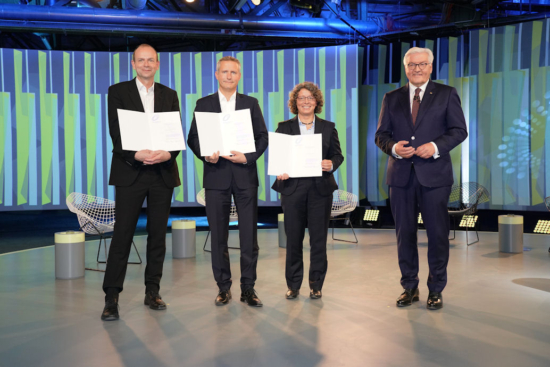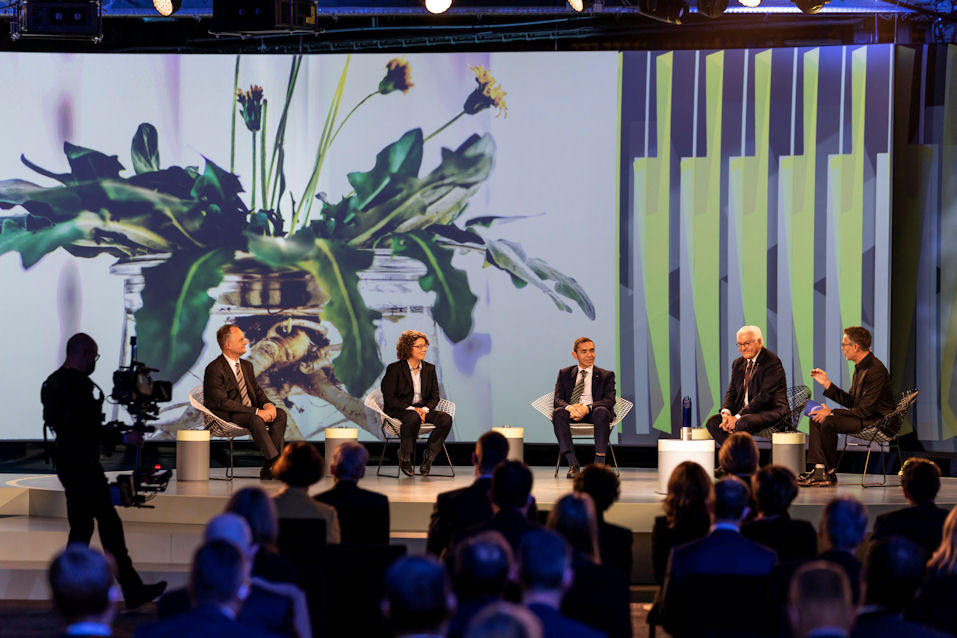‘Circle of the Best’ – presidential accolade for Dandelion rubber researchers
 German President Frank-Walter Steinmeier (right) honoured the researchers (from left) Dirk Prüfer, Christian Schulze Gronover & Carla Recker (Photo: Deutscher Zukunftspreis; Bildschön)
German President Frank-Walter Steinmeier (right) honoured the researchers (from left) Dirk Prüfer, Christian Schulze Gronover & Carla Recker (Photo: Deutscher Zukunftspreis; Bildschön)
On Wednesday, Germany’s president Frank-Walter Steinmeier announced the winner of the 2021 Deutscher Zukunftspreis (German Future Prize), an accolade bestowed upon those promoting technology and innovation within the country. This year the award went, perhaps predictably, to the research team at Biontech for their work developing Pfizer’s Covid-19 mRNA vaccine, but the awards event also honoured research into finding a viable substitute for the rubber from the Pará tree.
Steinmeier admitted Continental’s Dr Carla Recker, Dr Dirk Prüfer from the University of Münster and the Fraunhofer Institute for Molecular Biology and Applied Ecology (IME) and Dr Christian Schulze Gronover, also from the IME, into the ‘Circle of the Best’ for their work on “sustainable tyres through Russian dandelion” and presented the trio with certificates in honour of their efforts.
Upon being nominated in September, Carla Recker, who heads the Materials Chemistry expert field at Continental Tires, called inclusion on the three-project shortlist a “great honour” that “once again confirms the potential of a new raw material source for natural rubber.” She also reported that together with other members of the project network, the Continental research team has managed to significantly advance research into the entire Russian dandelion value chain.
“The industrialisation of the cultivation of dandelion rubber is the goal of our long-term project, where the key to success is mutual trust and perseverance,” she added. “Our first, series-produced bicycle tyre made from dandelion rubber, the Urban Taraxagum, shows that marketable products made of natural rubber from the dandelion plant are possible.”
Dr Recker & colleagues were one of three finalists (Photo: Deutscher Zukunftspreis; Bildschön)
Top priority in fight against climate change
We’ve followed the project for the past decade and caught up with Dr Recker and her colleagues shortly before the Covid-19 pandemic. Although there are numerous reasons for seeking an alternative source of rubber, the researchers’ aims are very much in keeping with the current post-Glasgow zeitgeist. “The protection of our tropical forest is a top priority in the fight against climate change,” emphasised Dirk Prüfer. “For this reason, the natural rubber processing industry also needs to rethink. Our approach to sustainably gaining natural rubber from dandelions can counteract many socio-economic and ecological challenges in these regions.” He added that sourcing raw materials close to tyre plants also reduces CO2 emissions resulting from long transport routes.
A major challenge
Research has focused on the Taraxacum genus of dandelion, which primarily grows wild in Kazakhstan and contains more rubber than other dandelion species. Rubber quantities within wild plants are nonetheless insufficient for viable commercial extraction, and wild plants don’t provide stable yields. The path to establishing Russian dandelion as a cultivatable raw material source has thus posed a major challenge for the researchers.
“Through consistent, knowledge-based action and with modern analytics, we have worked with a plant breeder to establish high-yielding and hardy plants from wild Russian dandelion,” said Christian Schulze Gronover. “We have also developed an environmentally friendly process for extracting rubber from the roots of the plants.”
Schulze Gronover and his colleagues have relied upon DNA markers to aid their breeding programme. Such markers are spots naturally present in genetic material and can be detected in the laboratory. Thanks to the markers, the researchers can examine the plant seedlings to determine whether they have the properties they desire, such as a higher rubber content, and estimate whether it is worth continuing to breed with these plants.
About the Deutscher Zukunftspreis
The Deutscher Zukunftspreis has been awarded by Germany’s President annually since 1997 and is considered one of the country’s most important innovation awards. It honours outstanding technical, engineering and scientific achievements that lead to market-ready products. After intensive review, the major German scientific and business associations propose innovative developments for the award. A jury of experts from a range of fields selects three teams of researchers and their innovation from a large number of projects every year in a multi-stage process, to progress to the final round of the award.





Comments